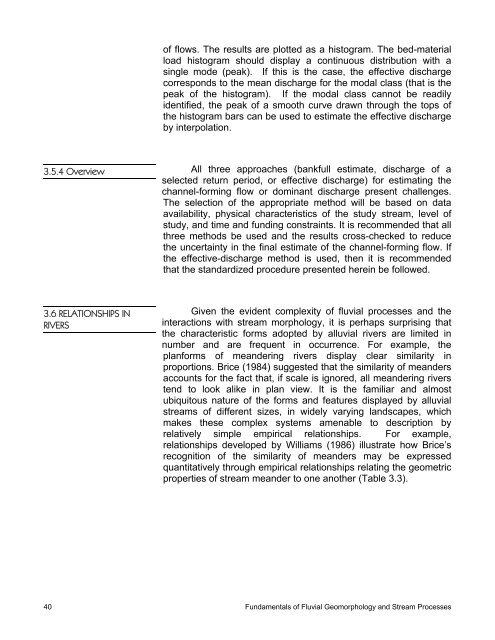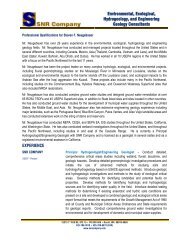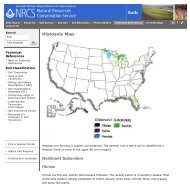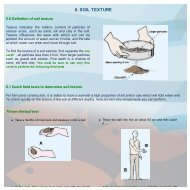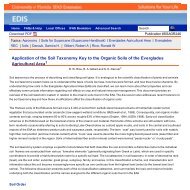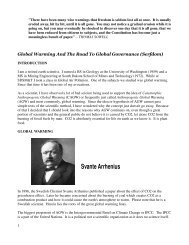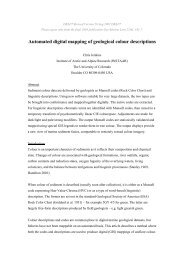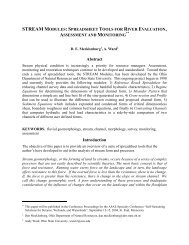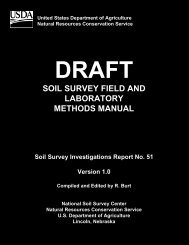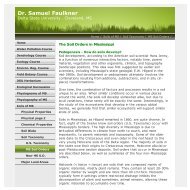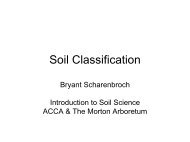chapter 3 fundamentals of fluvial geomorphology and stream ...
chapter 3 fundamentals of fluvial geomorphology and stream ...
chapter 3 fundamentals of fluvial geomorphology and stream ...
Create successful ePaper yourself
Turn your PDF publications into a flip-book with our unique Google optimized e-Paper software.
<strong>of</strong> flows. The results are plotted as a histogram. The bed-materialload histogram should display a continuous distribution with asingle mode (peak). If this is the case, the effective dischargecorresponds to the mean discharge for the modal class (that is thepeak <strong>of</strong> the histogram). If the modal class cannot be readilyidentified, the peak <strong>of</strong> a smooth curve drawn through the tops <strong>of</strong>the histogram bars can be used to estimate the effective dischargeby interpolation.3.5.4 OverviewAll three approaches (bankfull estimate, discharge <strong>of</strong> aselected return period, or effective discharge) for estimating thechannel-forming flow or dominant discharge present challenges.The selection <strong>of</strong> the appropriate method will be based on dataavailability, physical characteristics <strong>of</strong> the study <strong>stream</strong>, level <strong>of</strong>study, <strong>and</strong> time <strong>and</strong> funding constraints. It is recommended that allthree methods be used <strong>and</strong> the results cross-checked to reducethe uncertainty in the final estimate <strong>of</strong> the channel-forming flow. Ifthe effective-discharge method is used, then it is recommendedthat the st<strong>and</strong>ardized procedure presented herein be followed.3.6 RELATIONSHIPS INRIVERSGiven the evident complexity <strong>of</strong> <strong>fluvial</strong> processes <strong>and</strong> theinteractions with <strong>stream</strong> morphology, it is perhaps surprising thatthe characteristic forms adopted by alluvial rivers are limited innumber <strong>and</strong> are frequent in occurrence. For example, theplanforms <strong>of</strong> me<strong>and</strong>ering rivers display clear similarity inproportions. Brice (1984) suggested that the similarity <strong>of</strong> me<strong>and</strong>ersaccounts for the fact that, if scale is ignored, all me<strong>and</strong>ering riverstend to look alike in plan view. It is the familiar <strong>and</strong> almostubiquitous nature <strong>of</strong> the forms <strong>and</strong> features displayed by alluvial<strong>stream</strong>s <strong>of</strong> different sizes, in widely varying l<strong>and</strong>scapes, whichmakes these complex systems amenable to description byrelatively simple empirical relationships. For example,relationships developed by Williams (1986) illustrate how Brice’srecognition <strong>of</strong> the similarity <strong>of</strong> me<strong>and</strong>ers may be expressedquantitatively through empirical relationships relating the geometricproperties <strong>of</strong> <strong>stream</strong> me<strong>and</strong>er to one another (Table 3.3).40 Fundamentals <strong>of</strong> Fluvial Geomorphology <strong>and</strong> Stream Processes


